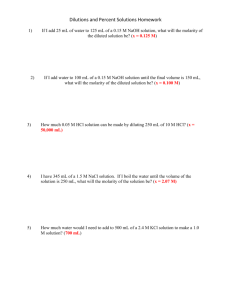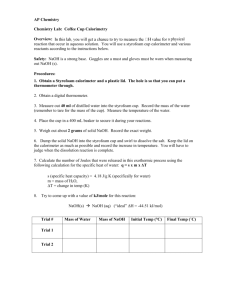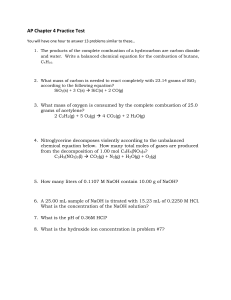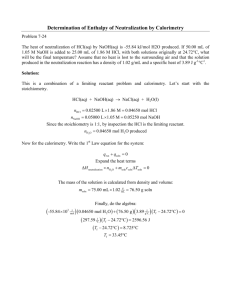ADDITIVITY OF HEATS OF REACTION: HESS’S LAW WITH LABQUEST
advertisement
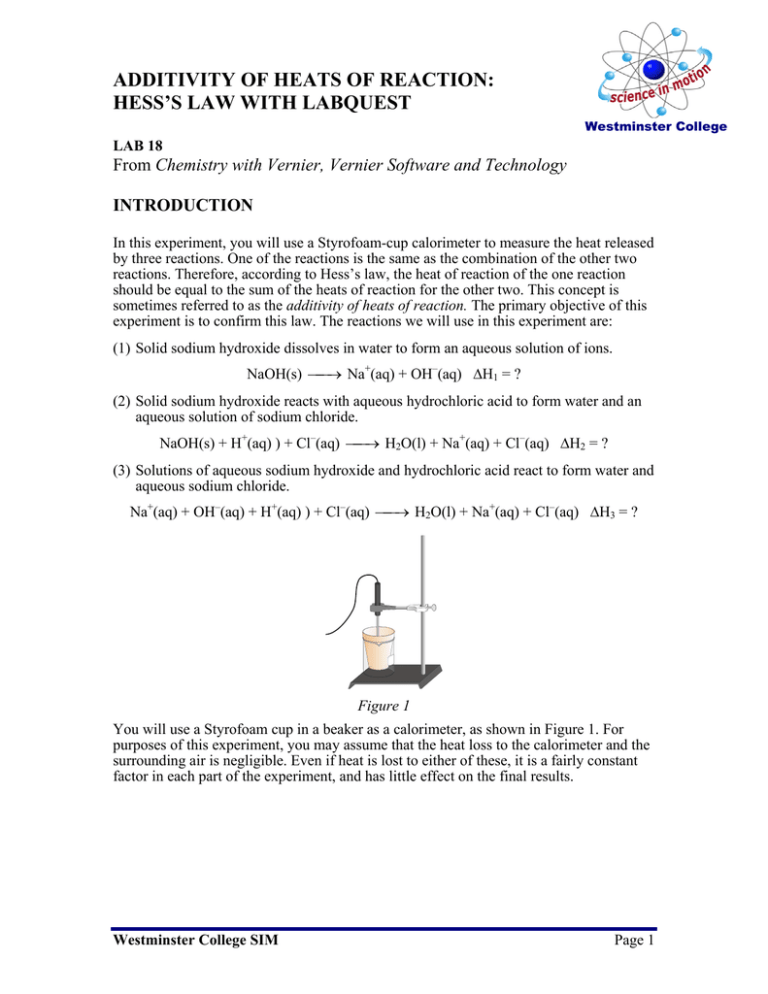
ADDITIVITY OF HEATS OF REACTION: HESS’S LAW WITH LABQUEST Westminster College LAB 18 From Chemistry with Vernier, Vernier Software and Technology INTRODUCTION In this experiment, you will use a Styrofoam-cup calorimeter to measure the heat released by three reactions. One of the reactions is the same as the combination of the other two reactions. Therefore, according to Hess’s law, the heat of reaction of the one reaction should be equal to the sum of the heats of reaction for the other two. This concept is sometimes referred to as the additivity of heats of reaction. The primary objective of this experiment is to confirm this law. The reactions we will use in this experiment are: (1) Solid sodium hydroxide dissolves in water to form an aqueous solution of ions. NaOH(s) ⎯⎯→ Na+(aq) + OH–(aq) ΔH1 = ? (2) Solid sodium hydroxide reacts with aqueous hydrochloric acid to form water and an aqueous solution of sodium chloride. NaOH(s) + H+(aq) ) + Cl–(aq) ⎯⎯→ H2O(l) + Na+(aq) + Cl–(aq) ΔH2 = ? (3) Solutions of aqueous sodium hydroxide and hydrochloric acid react to form water and aqueous sodium chloride. Na+(aq) + OH–(aq) + H+(aq) ) + Cl–(aq) ⎯⎯→ H2O(l) + Na+(aq) + Cl–(aq) ΔH3 = ? Figure 1 You will use a Styrofoam cup in a beaker as a calorimeter, as shown in Figure 1. For purposes of this experiment, you may assume that the heat loss to the calorimeter and the surrounding air is negligible. Even if heat is lost to either of these, it is a fairly constant factor in each part of the experiment, and has little effect on the final results. Westminster College SIM Page 1 Hess’s Law with Labquest OBJECTIVES In this experiment, you will • • • • Combine equations for two reactions to obtain the equation for a third reaction. Use a calorimeter to measure the temperature change in each of three reactions. Calculate the heat of reaction, ΔH, for the three reactions. Use the results to confirm Hess’s law. PRE-LAB EXERCISE In the space below, combine two of the above equations algebraically to obtain the third equation. Indicate the number of each reaction on the shorter lines. ______ ________________________________________________________________ ______ ________________________________________________________________ ______ ________________________________________________________________ MATERIALS LabQuest LabQuest App Temperature Probe 50 mL of 1.0 M NaOH 50 mL of 1.0 M HCl 100 mL of 0.50 M HCl 100 mL of water 4.00 g of solid NaOH ring stand utility clamp stirring rod Styrofoam cup 250 mL beaker PROCEDURE Reaction 1 1. Obtain and wear goggles. 2. Connect the Temperature Probe to LabQuest and choose New from the File menu. If you have an older sensor that does not auto-ID, manually set up the sensor. 3. Use a utility clamp to suspend a Temperature Probe from a ring stand as shown in Figure 1. 4. Place a Styrofoam cup into a 250 mL beaker as shown in Figure 1. Measure out 100.0 mL of water into the Styrofoam cup. Lower the Temperature Probe into the solution. 5. Weigh out about 2 g of solid sodium hydroxide, NaOH, and record the mass to the nearest 0.01 g. Since sodium hydroxide readily picks up moisture from the air, it is necessary to weigh it and proceed to the next step without delay. CAUTION: Handle the NaOH and resulting solution with care. 6. Start data collection and obtain the initial temperature, t1. Monitor temperature (in °C) on the screen. It may take several seconds for the Temperature Probe to equilibrate at the temperature of the solution. After three or four readings at the same temperature have been obtained, add the solid NaOH to the Styrofoam cup. Using the stirring rod, stir continuously until the temperature has maximized and then begun to drop. Record the maximum temperature, t2. Westminster College SIM Page 2 Hess’s Law with Labquest 7. Data collection will stop after 3 minutes (or stop before 3 minutes have elapsed). 8. To confirm the initial (t1) and final (t2) values you recorded earlier, examine the data points along the curve on the displayed graph. As you tap each point, the temperature and time values are displayed to the right of the graph. 9. Rinse and dry the Temperature Probe, Styrofoam cup, and stirring rod. Dispose of the solution as directed by your instructor. Reaction 2 10. Repeat Steps 4–9, using 100.0 mL of 0.50 M hydrochloric acid, HCl, instead of water. Use the same amount of solid NaOH as before. CAUTION: Handle the HCl solution and NaOH solid with care. Reaction 3 11. Repeat Steps 4–9, initially measuring out 50.0 mL of 1.0 M HCl (instead of water) into the Styrofoam calorimeter. In Step 5, instead of solid NaOH, measure 50.0 mL of 1.0 M NaOH solution into a graduated cylinder. After 3–4 temperature readings have been taken to determine the initial temperature of the 1.0 M HCl, add the 1.0 M NaOH solution to the Styrofoam cup. CAUTION: Handle the HCl and NaOH solutions with care. PROCESSING THE DATA 1. Determine the mass of 100 mL of solution for each reaction (assume the density of each solution is 1.00 g/mL). 2. Determine the temperature change, Δt, for each reaction. 3. Calculate the heat released by each reaction, q, by using the formula: q = Cp•m•Δt (Cp = 4.18 J/g°C) Convert joules to kJ in your final answer. 4. Find ΔH ( ΔH = –q ). 5. Calculate moles of NaOH used in each reaction. In Reactions 1 and 2, this can be found from the mass of the NaOH. In Reaction 3, it can be found using the molarity, M, of the NaOH and its volume, in L. 6. Use the results of the Step 4 and Step 5 calculations to determine ΔH/mol NaOH in each of the three reactions. 7. To verify the results of the experiment, combine the heat of reaction (ΔH/mol) for Reaction 1 and Reaction 3. This sum should be similar to the heat of reaction (ΔH/mol) for Reaction 2. Using the value in Reaction 2 as the accepted value and the sum of Reactions 1 and 3 as the experimental value, find the percent error for the experiment. Westminster College SIM Page 3 Hess’s Law with Labquest DATA AND CALCULATIONS Reaction 1 Reaction 2 Reaction 3 1. Mass of solid NaOH g g 2. Mass (total) of solution g g g 3. Final temperature, t2 °C °C °C 4. Initial temperature, t1 °C °C °C 5. Change in temperature, Δt °C °C °C kJ kJ kJ kJ kJ kJ mol mol mol kJ/mol kJ/mol kJ/mol (no solid NaOH mass) 6. Heat, q 7. ΔH 8. Moles of NaOH 9. ΔH/mol 10. Experimental value kJ/mol 11. Accepted value kJ/mol 12. Percent error Westminster College SIM % Page 4
